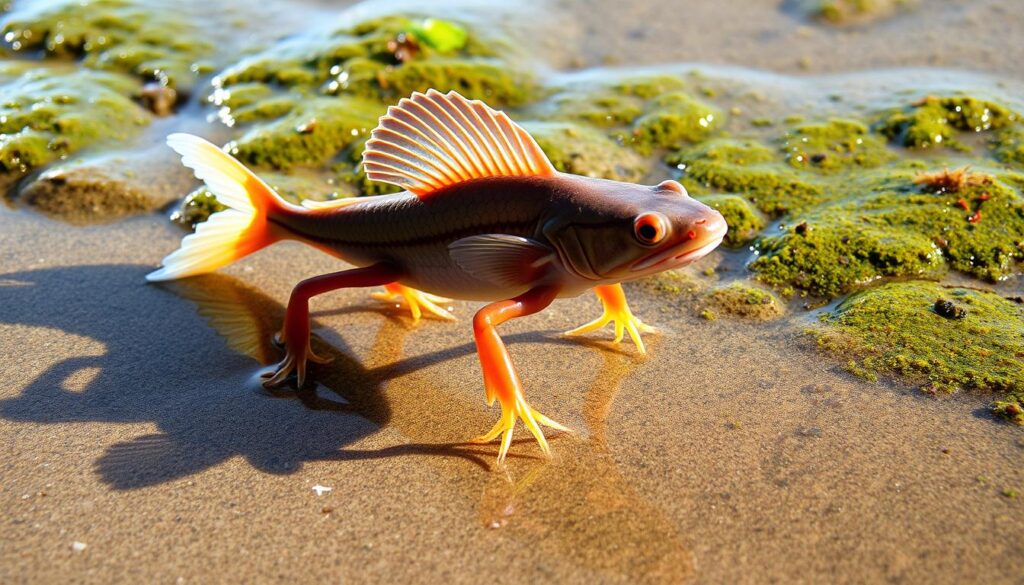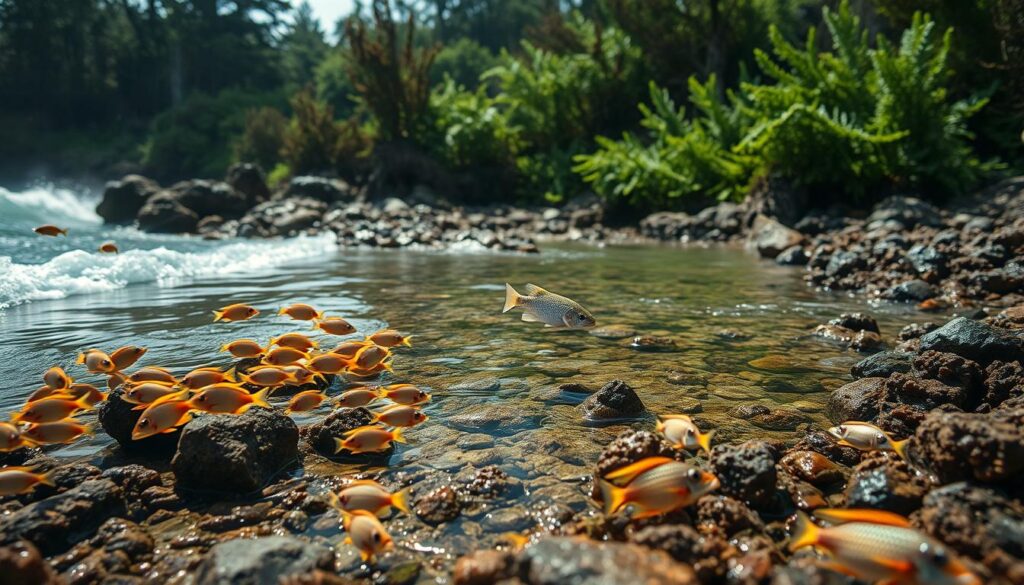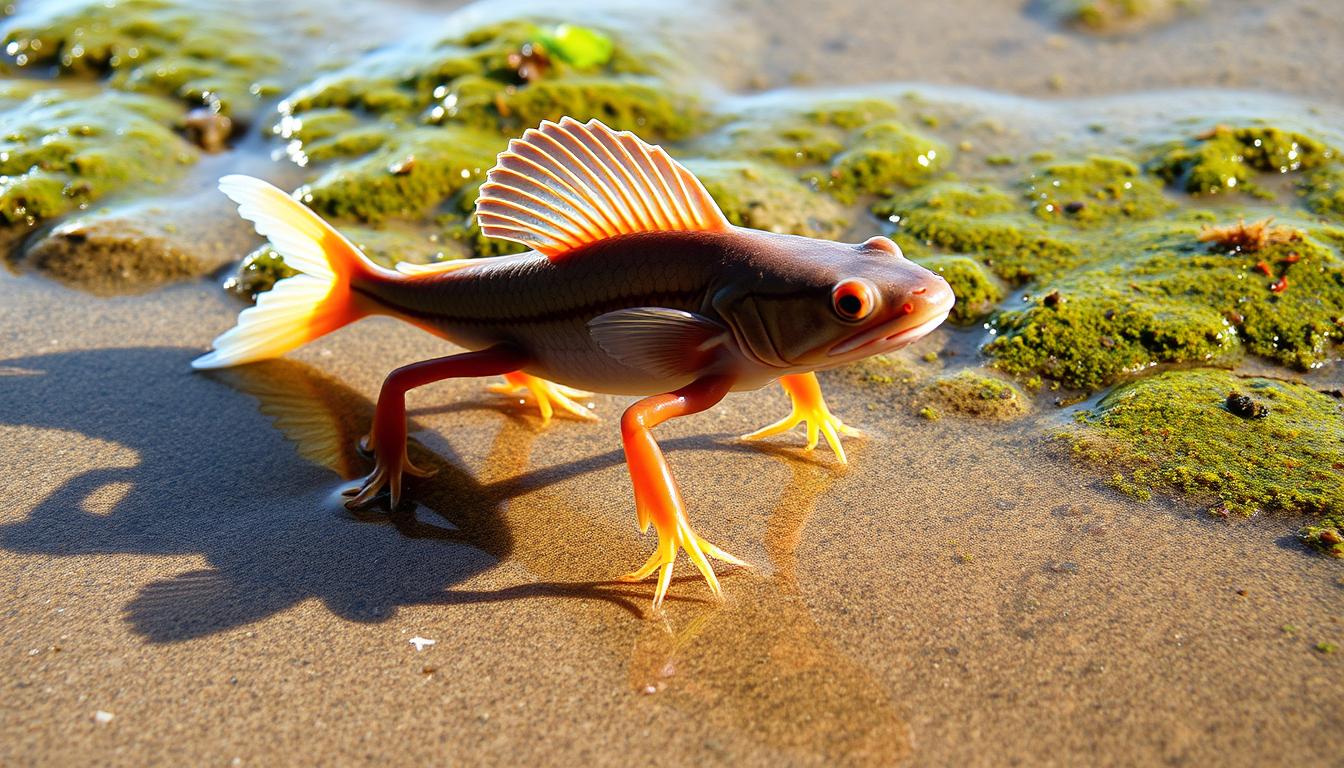Imagine a world where fish can walk on land. These amazing creatures, known as amphibious fish, live in both water and on land. They have evolved special ways to survive and thrive in different places. From the mudskipper to the walking catfish, these fish amaze us with their ability to walk on land.

Fish that can walk on land have special features for both water and land. These incredible animals can live in and out of water. They inspire scientific research and wonder, as we learn about their amazing abilities.
Introduction to Walking Fish
As we explore fish that can walk on land, we find amazing diversity. Amphibious fish have evolved to thrive in many environments. They have powerful fins and advanced breathing, making them unique.
Key Takeaways
- Fish that can walk on land are known as amphibious fish
- Walking fish species have evolved unique adaptations to survive in both water and on land
- Amphibious fish have developed specialized features such as powerful fins and advanced breathing mechanisms
- Fish that can walk on land can be found in various environments around the world
- Walking fish species continue to inspire scientific research and wonder
- Amphibious fish are an important part of their ecosystems, playing a vital role in the balance of nature
The Remarkable World of Fish That Can Walk on Land
Fish are known for living in water, but some can also survive on land. These fish have special adaptations that let them move and breathe outside of water. They can thrive in many environments thanks to their unique abilities.
Some fish, like mudskippers and walking catfish, can walk on land. They live in shallow water or need to move between bodies of water. Their strong fins and muscles help them push out of the water and move around on land.
To understand how these fish walk on land, we need to look at their behavior and physiology. By studying them, we learn how they thrive in both water and on land. Their special adaptations help them succeed in different environments.
Some key aspects of their behavior and physiology include:
- Strong fins and muscles that allow them to push themselves up and out of the water
- Specialized skin that helps to prevent water loss and to protect them from the elements
- Ability to breathe air and to extract oxygen from both water and air
Evolution of Walking Abilities in Fish
The evolution of walking in fish is a complex and fascinating process. It has allowed certain fish species to adapt to their environments in unique ways. These species have developed the necessary adaptations to walk on land, including changes in their fins, skeletal system, and breathing mechanisms. This process has been shaped by various factors, such as the need to find food, escape predators, or breed.
One of the key factors in the evolution of walking abilities in fish is the development of stronger fins that can support their body weight on land. Some fish species have evolved fins that can be used as makeshift legs, allowing them to push themselves forward and move around on land. Additionally, some species have developed more efficient breathing mechanisms, such as lungs or air-breathing organs, which enable them to survive out of water for extended periods.
Some examples of fish species that have evolved walking abilities include the mudskipper and the walking catfish. These species have developed unique adaptations, such as powerful fins and specialized breathing mechanisms, that allow them to thrive in both aquatic and terrestrial environments. The evolution of walking abilities in these species is a testament to the incredible diversity and adaptability of fish.
The study of the evolution of walking abilities in fish can provide valuable insights into the history of life on Earth and the processes that have shaped the diversity of species on our planet. By examining the adaptations and evolutionary pressures that have led to the development of walking abilities in fish, scientists can gain a better understanding of the complex interactions between species and their environments.
Some key points to consider when exploring the evolution of walking abilities in fish include:
- The development of stronger fins and more efficient breathing mechanisms
- The importance of adaptations such as lungs or air-breathing organs
- The role of environmental pressures, such as the need to find food or escape predators, in shaping the evolution of walking abilities
Meet the Walking Catfish: A Master of Land Navigation
The walking catfish is a fascinating species that has adapted to life on land. It shows its remarkable ability to navigate through terrestrial environments with ease. This fish has evolved to become a master of land navigation, using its powerful fins and robust body to move around on land.
One of the key survival techniques employed by the walking catfish is its ability to breathe air. This allows it to survive for extended periods out of water.
Some of the notable characteristics of the walking catfish include:
- Powerful fins that allow for movement on land
- A robust body that provides support and stability
- Ability to breathe air, enabling survival on land
In terms of geographic distribution, the walking catfish can be found in various regions. It thrives in freshwater habitats and brackish environments. Its ability to thrive in different environments has made it a successful species, with a wide range of distribution across the globe.
The walking catfish is an excellent example of a species that has developed unique survival techniques. It has adapted to its environment, making it a master of land navigation.
The Fascinating Mudskipper: Life Between Two Worlds
The mudskipper is a unique creature that lives in aquatic and terrestrial environments. It spends its life between water and land. This fish has adapted to survive in both places, showing how flexible life can be.
One of the mudskipper’s key adaptations is its ability to breathe air. This lets it stay out of water for a long time. In its natural habitat, it moves through shallow, tropical waters with ease.
The mudskipper’s life is complex. It moves between water and land for food, shelter, and mates. This lifestyle has led to special physical and behavioral traits. For example, it can move on land and has complex social interactions.
Some of the key features of the mudskipper’s life between two worlds include:
- Adaptation to survive in low-oxygen environments
- Ability to move on land using powerful fins
- Complex social interactions and mating rituals
The mudskipper’s ability to thrive in both water and land makes it fascinating to study. Its unique adaptations have allowed it to succeed in many habitats. By studying the mudskipper, we can learn more about the complex relationships between species and their environments.
Anatomical Adaptations for Land Movement
Fish that can walk on land have evolved special anatomical adaptations. These changes help them survive in both water and on land. They have modified fin structures that support their weight and help them move on land.
Some key adaptations include:
- Stronger fins that can act as limbs, allowing fish to push themselves forward and maintain balance on land
- Development of breathing mechanisms that can extract oxygen from the air, such as lungs or air-breathing organs
- Modifications to their skin that prevent water loss and protect them from the elements, such as thickened scales or mucus-covered skin
These changes let some fish move onto land and explore new places. This increases their chances of survival and reproduction. Studying these adaptations helps us understand life on Earth and how species interact with their environments.
Learning about the anatomical adaptations of fish that walk on land shows us the amazing diversity of life. More research can also help us protect these unique species.
Survival Strategies and Behaviors
Fish that can walk on land have special survival strategies for both water and land. They have unique ways to find food, avoid predators, and interact with others. In water, they use camouflage and speed to hunt and stay safe. On land, they move with powerful fins and search for food.
These fish can breathe air and soak up moisture through their skin. This lets them stay out of water for a long time. They also save energy and find food in both places. For example, they smell out food on land.

They live in groups and talk to each other in many ways. They have a leader in their group. These social behaviors help them survive and do well in both water and land.
Some important survival strategies and behaviors of these fish are:
- Using their powerful fins to move and find food on land
- Employing camouflage and speed to catch prey and avoid predators in aquatic environments
- Conserving energy and finding food in both aquatic and terrestrial environments
- Communicating with each other using a variety of signals
Environmental Factors Driving Terrestrial Abilities
Environmental factors are key in making fish develop terrestrial abilities. The need to adapt to new environments has led to unique traits in some species. Terrestrial abilities help fish survive by escaping predators, finding food, and breeding in new places.
Habitat pressures, like food and shelter availability, push fish to develop terrestrial abilities. For instance, some fish can move on land to avoid predators or find food in areas with little water.
Pressures on Habitat
Climate changes, like water temperature shifts, also shape fish terrestrial abilities. As environments change, fish adapt, leading to new traits and abilities. Key factors include:
- Availability of food and shelter
- Predator avoidance
- Changes in water temperature or availability
Influence of Climate
Understanding what drives fish terrestrial abilities is vital for conservation. Recognizing habitat pressures and climate influences helps protect these unique species. This ensures their survival for future generations.
Conservation Challenges for Walking Fish Species
Walking fish species face many challenges that threaten their survival. One big issue is habitat loss caused by human activities like deforestation and urbanization. This forces them to adapt to new environments, making survival hard.
The effects of climate change also harm walking fish species. Rising temperatures and changing weather patterns disrupt their ecosystems. To tackle these challenges, we need to protect their habitats and fight climate change.

- Habitat loss and degradation
- Climate change and its impacts on ecosystems
- Pollution and its effects on water quality
- Overfishing and unsustainable fishing practices
To beat these challenges, we must create and use effective conservation plans. These plans should meet the needs of walking fish species. By protecting these unique species and their habitats, we can help our planet’s ecosystems thrive.
Modern Research and New Discoveries
Recent studies have greatly improved our knowledge of fish biology, especially about walking fish. These new discoveries have revealed how fish physiology, behavior, and ecology are linked. They show us the amazing ways some fish can live in both water and on land.
Researchers have been looking closely at how fish move, breathe, and sense their surroundings. For instance, they found that some walking fish have special fins for walking on land. These fish also have unique ways to breathe, taking in oxygen from both water and air.
- Advances in our understanding of fish physiology and behavior
- Discoveries of new species of walking fish with unique adaptations
- Insights into the ecological importance of walking fish in their native habitats
As we delve deeper into the world of walking fish, modern research and new discoveries are key. They help us understand these incredible creatures better. By embracing these findings, we can appreciate and protect these remarkable species more.
The Role of Walking Fish in Ecosystem Balance
Walking fish are key to keeping ecosystem balance in check. They act as both hunters and hunted, thanks to their ability to walk on land. This unique skill lets them interact with their surroundings in ways that affect other species and shape their ecosystems.
Some important roles of walking fish in ecosystem balance include:
- Predator-prey relationships: They hunt insects, crustaceans, and small animals. This helps keep their ecosystem’s balance.
- Environmental impact: Walking fish help move nutrients from water to land. They also change their habitats through burrowing.
- Nutrient transport: By moving between water and land, they carry nutrients. This supports plant growth and other organisms.
In terms of predator-prey relationships, walking fish are a vital food source. They are eaten by birds, mammals, and other fish. Their environmental impact is also big, helping keep their ecosystems healthy and diverse.
Overall, walking fish are vital for ecosystem balance. Losing them could harm the health and strength of their ecosystems. By understanding their importance, we can work to protect these unique creatures.
Conclusion: The Future of Land-Walking Fish in Our Changing World
The future of land-walking fish is uncertain. These amazing creatures can live in water and on land. But, they face many challenges in our changing world.
Habitat loss and climate change are big threats. Yet, there’s hope. Research and conservation efforts can help protect them. We need to work together to save these unique fish.
Protecting land-walking fish is key to our planet’s health. They show us how life can adapt. By saving these fish, we also protect the ecosystems they live in.
FAQ
What is the unique ability of some fish to walk on land?
Some fish, like mudskippers and walking catfish, can walk on land. This lets them live in both water and on land.
How do fish adapt to move on land?
Fish that walk on land have special features. They have fins that act like legs, ways to breathe air, and skin that keeps water out.
What are some of the key characteristics of the walking catfish?
Walking catfish have strong fins and a sturdy body. They can breathe air and move on land. They live in Southeast Asia and have special ways to survive in both water and on land.
How do mudskippers adapt to life between two worlds?
Mudskippers spend a lot of time on land. They can breathe air and move with their fins. They have complex social lives and special ways to keep water in and protect themselves from predators.
What environmental factors drive the development of terrestrial abilities in fish?
Fish develop land abilities for many reasons. They might need to escape predators or find food. Changes in water temperature or availability also play a role.
What are the conservation challenges facing walking fish species?
Walking fish face big challenges like habitat loss and pollution. We need to protect their homes and keep their ecosystems healthy to save them.
What are some of the latest research findings on walking fish species?
New studies have uncovered a lot about walking fish. We now know more about their biology, behavior, and how they evolved. These discoveries help us understand how they live in both water and on land.
